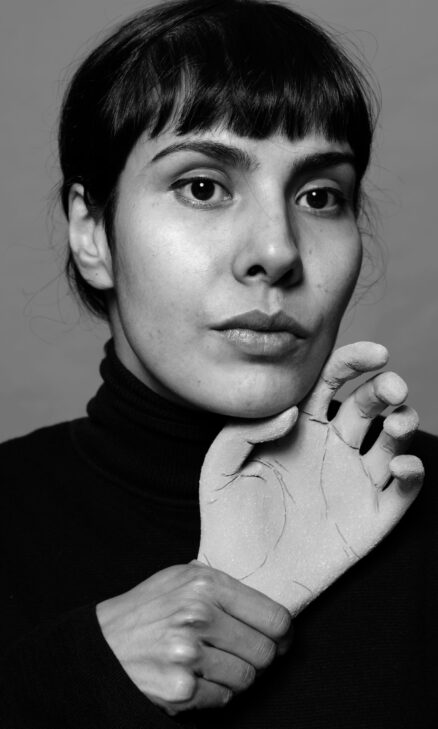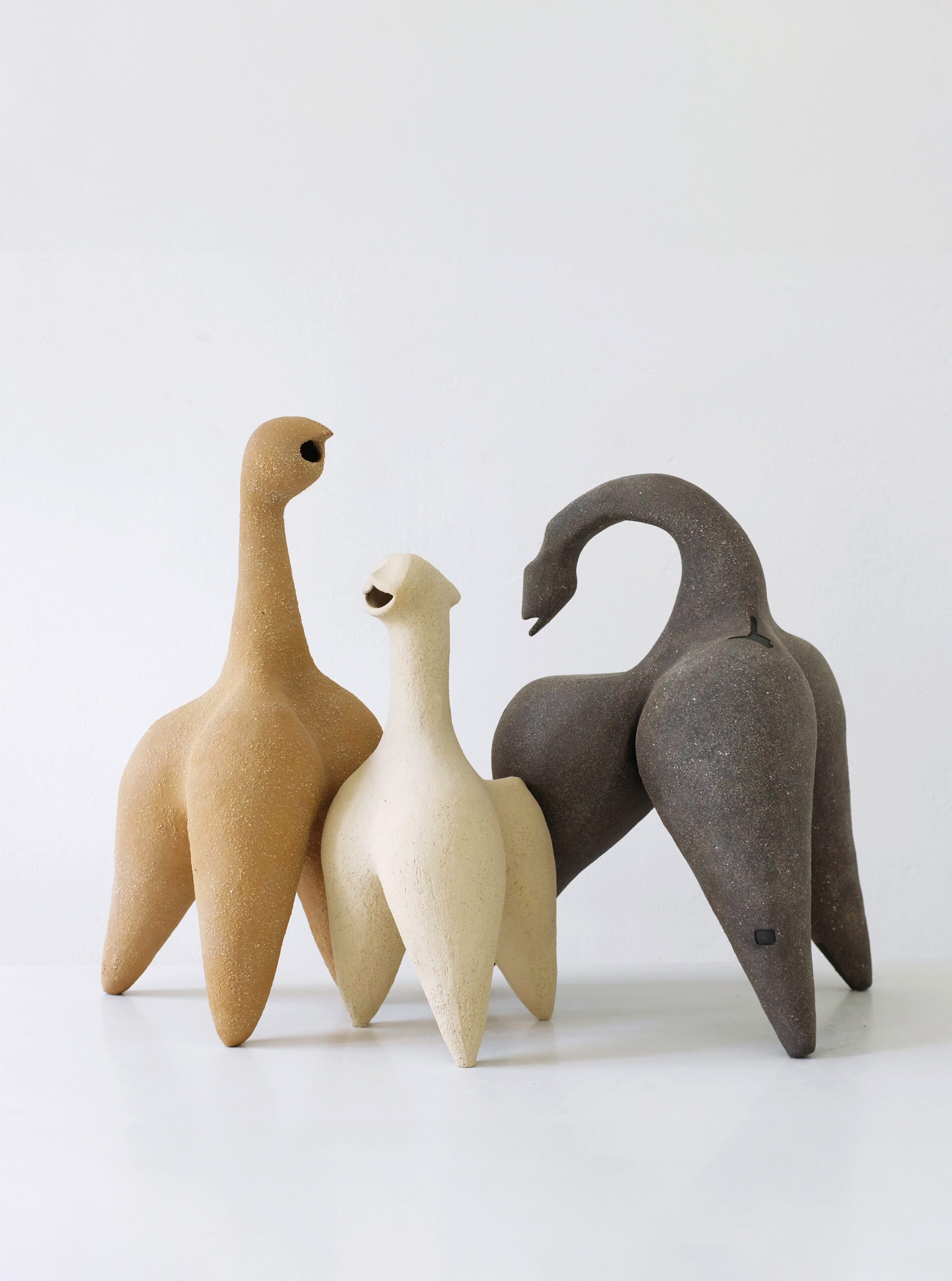Latika Nehra
Self-taught ceramic artist Latika Nehra creates biomorphic sculptural forms that fuse prehistoric pottery and science fiction, inviting speculative readings of our environment through clay, stone, and texture.
Self-taught ceramic artist Latika Nehra’s practice sits at the intersection of sculpture and speculative thought. Now based in Berlin, she works primarily with ceramics and stone to create almost unsettling forms that resemble relics from an imaginary future. Their construction, whether in clay or stone, evokes eroded fossils or machine parts from a distant future. Rendered in muted shades of ash, terracotta, and stone, Latika’s visual language draws on two contrasting influences. On one end, it is inspired by prehistoric pottery, where early tools mimicked natural shapes and served practical needs. On the other end, it reflects the influence of science fiction, both in form and philosophy; exploring technology’s evolving impact on our physiology, cognition, and sense of self. Through her vision, these two aspects fuse into porous, biomorphic forms, taking shape as sculptural art pieces for the contemporary audience. Her practice moves between freestanding sculpture and wall-mounted ceramics, producing works that are at once elegant and uncanny. With a background in visual communication from NID and a master’s in integrated design from Germany, Latika spent nearly a decade working as a graphic designer before turning to sculpture. Her time between India and Germany adds another layer to her understanding of form and material, rooted in tradition but shaped by constant movement. She remains connected to India’s craft communities even today, frequently returning to engage with local artisans and contribute to ongoing conversations around contemporary interpretations of heritage. Her work has been exhibited internationally, from Gallery Pangolin in London to Latitude 28 in New Delhi, and continues to grow across both Indian and European contemporary art circuits. Across projects, what remains consistent is her interest in creating objects that encourage more layered readings of our environment.



Latika speaks to Blur The Border :
Blur : As an artist who has dabbled in multiple mediums like painting, graphic design, and ceramics, what comes first to you, the art or the medium?
Latika : Always the thought, the emotional impulse or conceptual idea leads the way. The medium follows, whether it’s the fluidity of paint, the form of clay, or the intentionality of design. Of course, there have been times when it was the other way around, but at its core, my work begins with lived experience, then finds form.
Blur : Prehistoric pottery is a major inspiration for your work—what draws you to ancient forms, and how do you reimagine them in a futuristic, sci-fi context?
Latika : Prehistoric pottery helped me understand ceramics as a medium. Many ancient vessels & objects served both practical and ceremonial purposes, with forms that feel raw, intuitive, and essentially primal. I often think of science fiction today as playing the role mysticism once did, you know, offering imagined futures the way ancient myths framed the unknown. Maybe, therein lies the connection. I create my sculptures within speculative habitats, worlds that project forward, while the materiality and tactile engagement anchor you firmly in the present moment.
Blur : You split your time between Berlin and Jaipur—two vastly different cultural landscapes. How do these influences merge in your creative process?
Latika : It’s a beautiful contrast, like drawing from two vastly different worlds. Berlin offers modernity, experimentation, and many a times a bizarre creative edge, while Jaipur brings a deep sense of tradition and craft. I’m still figuring out whether they complement each other in my work or exist as parallel influences. Maybe they’ve already begun to merge in ways I don’t fully see yet.
Blur : Do you have a definitive process while creating? Are there any habits or rituals that help you get into a creative mindset?
Latika : No fixed process, a good mix of discipline & disorder. I often disconnect, immerse myself in research, drift, and then resurface to refine those thoughts into something tangible.
Blur : For artists that work with traditional mediums like ceramics today, how do you think the rise of digital and AI tools is changing the way they work?
Latika : While I don't believe AI tools are making everyone smarter, their benefits are clear. There are remarkable examples where AI has significantly accelerated research and development in nearly every domain. Still, there’s also a flood of AI-generated slop, misinformation, and just plain digital junk. As with our natural environments, we’re witnessing a kind of degradation online. It’s more important than ever to ask ourselves: what kind of digital ecosystems do we want to inhabit?
For artists who work slowly, by hand, and with traditional materials like clay, this digital acceleration can feel at odds with the depth and pace of their practice. So much is lost when learning becomes fast and surface-level—when we trade deep reading or hands-on making for endless scrolls of high-bandwidth images and videos. Critical thinking, especially the kind that deals with abstraction, takes time. It’s iterative. It’s slow.
Personally, I’m fascinated by broader concepts like transhumanism, solarpunk, and technogaianism. In that context, AI tools feel like a small part of a much larger transformation.
Blur : Beyond being an artist, you’ve built a distinct personal brand through social media. What drove this decision, and how crucial is visibility for artists now?
Latika : It wasn’t something I planned; it just unfolded naturally. I share moments of my process that aren’t visible in the final work, and that seems to resonate with people. But I don’t think artists should feel pressured to perform or constantly engage online. They need to focus on making the work and not be promoting it all the time. The work suffers. Social media often rewards aesthetics over substance, and if you're not careful, it can begin to shape your work. I feel that pressure too, but I always remind myself not to take things too seriously—that’s been a helpful motto. It’s important to laugh at yourself sometimes.
Maybe it's the job of curators, gallerists, and collectors to seek out good work and find quality beyond what's trending on social media or what has the largest following. There’s real value in art that doesn’t always have the loudest presence online.
Blur : Are there any other mediums you find interesting and would like to explore in the future?
Latika : Stone. I want to build a large-scale sculpture for a public square in India, or at a roundabout, a chowk.
Blur : If you were to collaborate with other artists, outside of your discipline, what is one collaboration you would love to do?
Latika : Khyati Trehan, Sanchit Sanwaria, and Kushagra Gupta are all incredibly talented digital artists. I’d love to collaborate with them to create digital glazes for some of my physical forms.